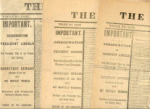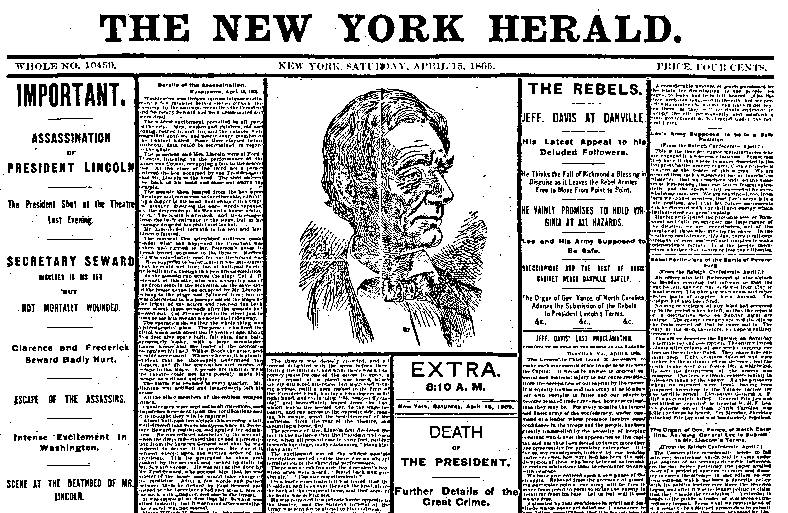|
The Most Abundant Newspaper Reproduction
If you have this "newspaper", you have one of many thousands of reproduction editions printed between about 1880 and the early 1900's. They are extremely abundant and have very little collector value. The "April 15, 1865 New York Herald" comes in more than twenty reprint variations.
Like virtually all reproductions of old newspapers, they look nothing like the originals.
Not Produced to Deceive Collectors
Some, perhaps most, of these imitations were made as advertising flyers. Their job was to catch the eye of passers-by as they were handed out on busy street corners across the nation. Others were made as souvenirs to sell to tourists at historical sites. At the time they were new, no one mistook them for original 1865 newspapers, but with the passage of time the facts of their origins have been forgotten. Judging from the vast numbers of them which have survived, these sheets accomplished their purpose, to catch and hold the public's attention, with uncommon effectiveness.
As few other fake antiques have, these spurious Heralds have created a great deal of confusion among the non-collecting public and they have fooled numerous antique dealers, librarians, and journalists. I have seen several books on newspaper history which illustrate the fakes as genuine. There was an article published in a Dallas newspaper a few days after the assassination of JFK which showed a senior citizen proudly displaying a family heirloom - the Herald reproduction that illustrates in this article. I see them on eBay constantly. Most surprisingly, in their "History of American Newspapers", the Smithsonian Institution shows one of the Lincoln portrait fantasy reproductions and claims it is genuine!
They Turn Up All the Time
Not a week goes by that someone does not contact me about one of these issues, which they are absolutely convinced is genuine because it has been in the family "since grandpa's time." Despite the accompanying family legends, in all these years not a single one reported to me by the non-collecting public has proved to be a genuine 1865 Herald.
It is worth remembering that the New York Herald, under the editorship of its founder, the irascible James Gordon Bennett, was consistently hostile to Lincoln and had printed many editorials savagely attacking Lincoln's character and policies. This fact makes it especially unlikely that a New Yorker desiring a memento of the murdered president would have chosen on that terrible Saturday to save for posterity an opposition newspaper, while pro-Lincoln papers such as the Times, Tribune, and Post were readily available at every newsstand. In addition, this newspaper was a local daily edition and did not circulate much outside of the metropolitan New York area. Specific weekly and semi-weekly editions were prepared for national distribution. Very few original examples of this paper have survived outside of library bound volumes of newspapers.
Diagnostics of the Fakes
The reproductions can be recognized by any of the following characteristics, none of which exist in the originals. If your specimen has just one of these characteristics, it is not genuine.
- Brittle, crumbling, browned, or yellowing paper. This is the quickest key to identify a fake. If the paper feels like modern newsprint, it is a fake. The originals were printed on rag paper, which does not discolor or become crumbly with age. Paper used by New York dailies in the spring of '65 has a characteristic "crisp" feeling,
 something like rice paper; it is thought to be English-made paper, captured from a Confederate blockade runner taken at Wilmington that February and subsequently auctioned off by the government. Original New York Heralds of this period remain white and flexible. The reproductions however were produced on a high sulfite woodpulp paper, nothing like the original paper, which was first manufactured in 1867 and in general use by about 1880. Items printed on this paper (which is still used today) are very frequently found split at the folds, browned, or chipping at the edges, or crumbling apart. Rag paper does not experience this type of deterioration. something like rice paper; it is thought to be English-made paper, captured from a Confederate blockade runner taken at Wilmington that February and subsequently auctioned off by the government. Original New York Heralds of this period remain white and flexible. The reproductions however were produced on a high sulfite woodpulp paper, nothing like the original paper, which was first manufactured in 1867 and in general use by about 1880. Items printed on this paper (which is still used today) are very frequently found split at the folds, browned, or chipping at the edges, or crumbling apart. Rag paper does not experience this type of deterioration.
Click on the thumbnail graphic for a large scan of several different fakes; note the variations in typefaces and the fold splits.
- "8:10 A.M. edition" - there was no such edition. This is the key diagnostic for the majority of reproductions. Remarkably, the Library of Congress website currently displays the obsolete 1955 version of their N.Y. Herald Information Circular, which incorrectly includes the 8:10 among the verified editions. The correct information, that all 8:10 AM editions are bogus, is clearly stated in the Library's current Herald Information Circular, which is dated 1972. Yet another example of the uncanny confusion that reigns with this paper! [Late addition, 2008 - The L.O.C. website now has the current info circular online]
- A frontpage portrait of Lincoln - another key diagnostic. Note that the portrait is beardless, which makes it almost five years out of date in 1865 since he grew his beard in 1860. The Herald printed no frontpage portraits at all at this time. Only the Philadelphia Inquirer possessed sophisticated illustration technology in 1865.
- "Whole No. 10459" - the original is numbered No. 10456 (some imitations bear the correct issue number).
- Two to four pages in length - the original is an eight page newspaper, except for the 10:00 A.M. Special Edition, which contains four pages. The reproductions were typically printed on single sheets of two pages or four pages. All pages following the front page are numbered in the originals (at the top left or right corner of the sheet, just like a modern newspaper), while the pages of the reproductions are almost always unnumbered.
- Large advertisements with text and/or illustrations wider than one column - these ads are the purpose for which the advertising editions were printed. The technology to print multi-column ads with lots of pictures did not exist in 1865. In a number of these varieties there are testimonial letters which bear dates in the 1890's and early 1900's, which you may take as a pretty convincing sign that the piece in question is not a real 1865 newspaper.
The following products are advertised in the reproductions and do not appear in the originals: Bitter Apple Tonic; Per-U-Na laxative; Brant's Pulmonary Balsam; Kitchel's Liniment and other patent medicines (at least seven distinct 4-page ad editions were issued by this company between 1890 and 1901; check the testimonial letters for the current dates!); Hood's Sarsparilla; Dr. Archambaud's Paris Vital Sparks; and the famous Grain-O Pure Coffee. Other circulars using the New York Herald motif to promote products not listed here are known to exist but are presently undocumented. There is also an April 15, 1865 "New York Special", produced by the J.W. Bryant Company modeled on a Herald assassination reprint with the Lincoln portrait.
Among the commonest historical souvenir reprint editions are the 2 page "Inaugural Edition", printed on a heavy parchment-like paper and sold for years at the Ford's Theater gift shop and the McKinley memorial issue (Washington, 1901) which falsely claims to have been reprinted "from one of only two known original plates left in existence." One reproduction edition contains excerpts from Lincoln's other writings, including the Gettysburg Address and the second State of the Union speech. There is also a modern reprint produced for a 1971 newspaper history exhibition in London, which exhibited a fake as original.
|
The Genuine New York Herald Editions
President Lincoln was shot at 9:30 p.m., Friday, April 14, 1865, while seated in a box at Ford's Theater. About the same time Secretary of State Seward, one of his sons, and a servant were knifed by an assassin who invaded their home. Lincoln was removed to a house across the street from the theater where he died at 7:22 a.m. Saturday morning.
News of the attacks reached the New York Herald by telegraph in time to make the first edition. Several other editions were issued during the day, reporting later developments, Lincoln's death, and the inauguration of Vice President Andrew Johnson as President.
The several original editions, six columns wide and printed on rag paper, can be distinguished by variations in the arrangement of textual material and captions, especially on page 1. Four editions have been identified; they are categorized by the time of the latest news bulletin contained, as follows:
2:00 a.m. Regular edition. 8 pages. A one-sentence "Two o'clock a.m." bulletin appears just above the caption "Press Despatches" in the third column and "The State Capital" appears near the top of the fourth column of the first page.
3:00 a.m. Special edition. 8 pages. The first, second, and third columns on page one are same as the 2:00 a.m. edition. In the fourth column the caption, "The State Capital," has been replaced by "The Latest News" and contains a sub-heading "Secretary Stanton to General Dix, War Department, Washington, April 15 - - 3:00 a.m." "The State Capital" has been moved to the sixth column.
10:00 a.m. Special edition. 4 pages, the inside ones being identical to pages 4, 5, and 8 of the 2:00 a.m. and 3:00 a.m. editions and so numbered. The fifth column of the first page is headed "Postscript ... Death of the President. This is the first edition with heavy column lines, which are limited to a portion of the fifth column.
2:00 p.m. Inauguration Edition. 8 pages, pages 2 through 7 being the same as the 2:00 a.m. and 3:00 a.m. editions. All columns on the first page have heavy lines; captions in the fifth column under "Postscript" same as 10:00 a.m. Special Edition with the addition of a reward notice. The caption "The Rebels" has slipped from the fifth column to the sixth column, displacing other items. The eighth page has been significantly changed by the addition of a bold-faced caption "Extra" in the second column and "Inauguration of ... Johnson" in the fourth column. Inexplicably the date "Frtday, April 14, 1865, " appears in the running head on page eight of this edition.
A 10:00 a.m. "Reward Edition" and a 3:30 p.m. "Special Edition" have also been reported.
The above data is from Library of Congress Reference Department, Serial Division Information Circular 12.
|
See also my collector information pages on
The Ulster County Gazette of January 4, 1800, another extremely common old newspaper reproduction.
The Daily Citizen of July 2, 1863, the most common Confederate newspaper reproduction.
The Honolulu Star-Bulletin of December 7, 1941, the most common modern newspaper replica.
Our Collector Information Page for general advice and more data on detecting reproductions.
You can get further details of the Herald and the sixteen other most common newspaper reproductions from the Library of Congress website.
We hope you have found this page useful and informative. Please take a moment to let us know what you liked about this page or how it could be improved. Thanks for your feedback!
Navigate my Website:
|


